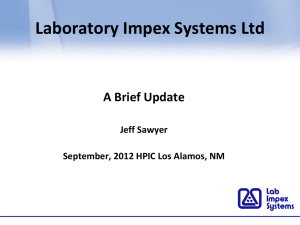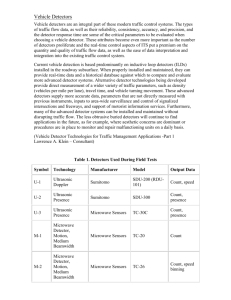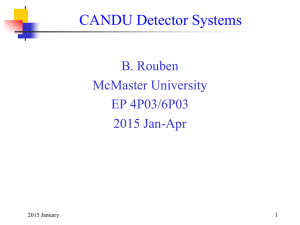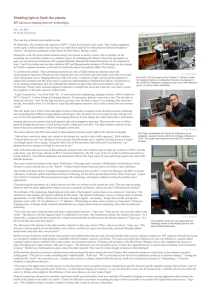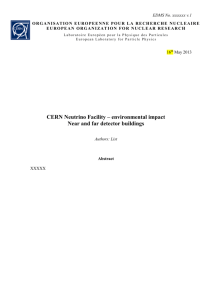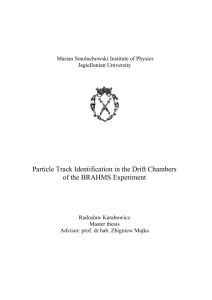EDITGASLAB_Description
advertisement
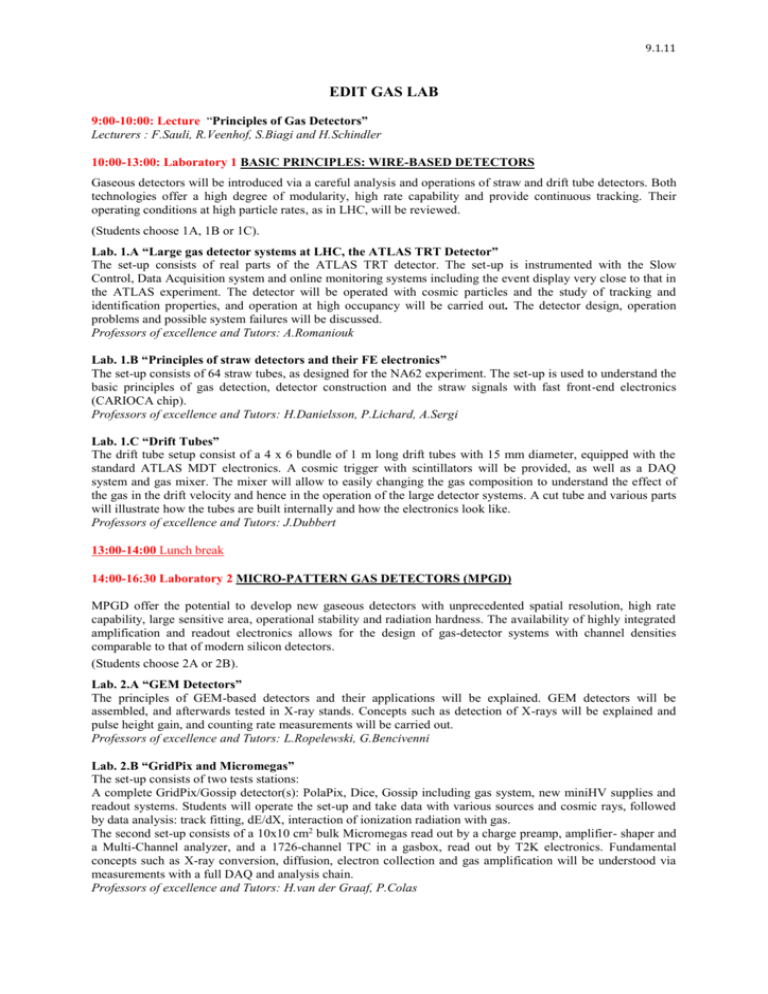
9.1.11 EDIT GAS LAB 9:00-10:00: Lecture “Principles of Gas Detectors” Lecturers : F.Sauli, R.Veenhof, S.Biagi and H.Schindler 10:00-13:00: Laboratory 1 BASIC PRINCIPLES: WIRE-BASED DETECTORS Gaseous detectors will be introduced via a careful analysis and operations of straw and drift tube detectors. Both technologies offer a high degree of modularity, high rate capability and provide continuous tracking. Their operating conditions at high particle rates, as in LHC, will be reviewed. (Students choose 1A, 1B or 1C). Lab. 1.A “Large gas detector systems at LHC, the ATLAS TRT Detector” The set-up consists of real parts of the ATLAS TRT detector. The set-up is instrumented with the Slow Control, Data Acquisition system and online monitoring systems including the event display very close to that in the ATLAS experiment. The detector will be operated with cosmic particles and the study of tracking and identification properties, and operation at high occupancy will be carried out. The detector design, operation problems and possible system failures will be discussed. Professors of excellence and Tutors: A.Romaniouk Lab. 1.B “Principles of straw detectors and their FE electronics” The set-up consists of 64 straw tubes, as designed for the NA62 experiment. The set-up is used to understand the basic principles of gas detection, detector construction and the straw signals with fast front-end electronics (CARIOCA chip). Professors of excellence and Tutors: H.Danielsson, P.Lichard, A.Sergi Lab. 1.C “Drift Tubes” The drift tube setup consist of a 4 x 6 bundle of 1 m long drift tubes with 15 mm diameter, equipped with the standard ATLAS MDT electronics. A cosmic trigger with scintillators will be provided, as well as a DAQ system and gas mixer. The mixer will allow to easily changing the gas composition to understand the effect of the gas in the drift velocity and hence in the operation of the large detector systems. A cut tube and various parts will illustrate how the tubes are built internally and how the electronics look like. Professors of excellence and Tutors: J.Dubbert 13:00-14:00 Lunch break 14:00-16:30 Laboratory 2 MICRO-PATTERN GAS DETECTORS (MPGD) MPGD offer the potential to develop new gaseous detectors with unprecedented spatial resolution, high rate capability, large sensitive area, operational stability and radiation hardness. The availability of highly integrated amplification and readout electronics allows for the design of gas-detector systems with channel densities comparable to that of modern silicon detectors. (Students choose 2A or 2B). Lab. 2.A “GEM Detectors” The principles of GEM-based detectors and their applications will be explained. GEM detectors will be assembled, and afterwards tested in X-ray stands. Concepts such as detection of X-rays will be explained and pulse height gain, and counting rate measurements will be carried out. Professors of excellence and Tutors: L.Ropelewski, G.Bencivenni Lab. 2.B “GridPix and Micromegas” The set-up consists of two tests stations: A complete GridPix/Gossip detector(s): PolaPix, Dice, Gossip including gas system, new miniHV supplies and readout systems. Students will operate the set-up and take data with various sources and cosmic rays, followed by data analysis: track fitting, dE/dX, interaction of ionization radiation with gas. The second set-up consists of a 10x10 cm2 bulk Micromegas read out by a charge preamp, amplifier- shaper and a Multi-Channel analyzer, and a 1726-channel TPC in a gasbox, read out by T2K electronics. Fundamental concepts such as X-ray conversion, diffusion, electron collection and gas amplification will be understood via measurements with a full DAQ and analysis chain. Professors of excellence and Tutors: H.van der Graaf, P.Colas 9.1.11 16:30-18:30 Laboratory 3 STRIP-BASED DETECTORS AND SIMULATION TOOLS (Students choose 3A or 3B). Lab. 3A “Muon spectrometers” Muon spectrometers at LHC are extremely large tracking systems. Its tremendous size is required to accurately measure the momentum of muons; they also provide level-1 triggering. These large systems use several gas detector technologies, among them, Resistive Plate Chambers (RPC) and Thin Gap Chambers (TGC). An RPC set up and a TGC set-up are used to explaining the basic principles of muon detection and how these systems operate at LHC; we will review the operating parameters and needed environmental conditions that make RPCs and TGCs suitable trigger detectors for the LHC experiments. The set ups are designed to be able to understand potential problems that can occur during operation (geometrical deformations, undesired changes in the gas mixture, modifications of the electrodes’ resistivity, etc) and how to identify them. Professors of excellence and Tutors: G.Mikenberg, R.Guida Lab. 3B “SIMULATION” Computer programs are used for the detailed simulation of two- and three-dimensional drift chambers. Field maps, wire sag that results from electrostatic and gravitational forces, electron and ion drift lines, transverse diffusion coefficients, electron mobilities, x(t)-relations, drift time tables, arrival time distributions, signals induced by charged particles traversing a chamber can be calculated. This set-up focus on understanding the basic detection physics of gas detectors; simulations of novel detector geometries will be carried out and compared with experimental data obtained earlier in the day in the other experimental set-ups. Students will simulate in real-time an MDT tube from the ionisation of gas molecules by muons, to the signals read out by the electronics. For this, we use the programs that served to optimise the Atlas MDTs and their electronics as currently installed in ATLAS. Participants will be able to vary the parameters, such as the gas mixture and the potentials, to develop a feeling for the mechanisms at play in such tubes. Magboltz has, for many years already, been the workhorse for the calculation of transport parameters in nearly arbitrary gas mixtures. The author of this program is available to demonstrate its use and to discuss the physics on which it is based. Professors of excellence and Tutors: R.Veenhof, S.Biagi
